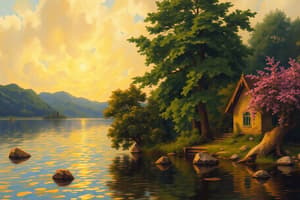Podcast
Questions and Answers
Qual es le adresse email del remittente?
Qual es le adresse email del remittente?
Quando fue le data del message?
Quando fue le data del message?
- January 1, 2025
- November 30, 2024
- December 17, 2024 (correct)
- December 17, 2023
Qual es le nomine del persona a quien le message esseva destinate?
Qual es le nomine del persona a quien le message esseva destinate?
- Amanda Campbell (correct)
- Robert Brown
- Emily Johnson
- John Smith
Qual es le subjecto del message?
Qual es le subjecto del message?
Qual es le ora quando le message esseva inviate?
Qual es le ora quando le message esseva inviate?
Flashcards
Correo electronic
Correo electronic
Un correo electronic es un message que se transmite electronicamente de un persona a un altere.
Adresse de correo electronic
Adresse de correo electronic
Un adresse de correo electronic es un unique identificator que permitte de trovar un persona in un sistema de correo electronic.
Subjecto
Subjecto
Un subjecto es un breve description del contento de un correo electronic.
Data
Data
Signup and view all the flashcards
Hora
Hora
Signup and view all the flashcards
Study Notes
Chapter 9 - South American Geography
- Andes Mountains: Major mountain range in South America, extending from Venezuela to Chile and Argentina.
- Llanos: Vast tropical grassland plain in northern South America, primarily in Venezuela and Colombia.
- Pampas: Fertile lowland region in South America, primarily in Argentina, Uruguay, and parts of Brazil, known for its rich grasslands suitable for farming and livestock.
- Cerrado: Vast tropical savanna ecoregion in Brazil, characterized by a mix of forests, grasslands, and shrubs, with a distinct wet and dry season.
- Amazon River: Second-longest river in the world, flowing primarily through the Amazon Rainforest in South America (Brazil, Peru, Colombia, and other countries).
- Rain Forest: Dense, warm, wet forests found in tropical regions near the equator, receiving high annual rainfall (typically over 100 inches).
- Slash and Burn: Agricultural technique used in tropical regions, involving cutting and burning vegetation to clear land for farming; the resulting ash fertilizes the soil.
- Terraced Farming: Method of farming on steep or hilly land, using step-like levels to cultivate.
Chapter 10 - Spanish Conquest
- Spanish Conquest: Period in the early 16th century, involving Spanish explorers and conquistadors (e.g., Hernán Cortés, Francisco Pizarro) invading and conquering major indigenous civilizations of the Americas, including the Aztec and Inca Empires.
Chapter 12 - European Geography and History
- Maquiladoras: Factories or assembly plants in Mexico, importing raw materials, processing/assembling them, and exporting the finished goods, often to the United States.
- NAFTA: Trade agreement (1994) between the United States, Canada, and Mexico aimed at reducing trade barriers and increasing economic cooperation.
- Inca: Powerful indigenous civilization in South America, renowned for advanced culture, engineering, and political systems; their empire spanned large parts of western Andes and coastal regions.
- Aztec: Mesoamerican culture thriving in central Mexico between the 14th and early 16th centuries.
- Mestizo: Person of mixed European (often Spanish) and Indigenous American ancestry, significant during the colonial period in Latin America.
- Mulatto: Person of mixed African and European (usually Spanish or Portuguese) ancestry, particularly prevalent in the Americas during the colonial period.
- Iberian Peninsula: Region in Europe that includes Spain & Portugal.
- Italian Peninsula: Region in Europe that includes Italy.
- Balkan Peninsula: Region in Europe that includes several countries.
- North European Plain: Vast lowland area extending from the Atlantic Ocean to the Ural Mountains; covers various European countries
- North Atlantic Drift: Powerful ocean current originating in the Gulf of Mexico, travelling across the Atlantic Ocean, affecting Northwestern Europe.
- Deforestation: Large-scale clearing of forests for various purposes.
- Land of the Midnight Sun: Region in the Arctic where the sun does not set during the summer months.
Chapter 13 - Cultural and Historical Topics in Europe
- Ethnic Differences: Cultural, linguistic, and ancestral distinctions between groups of people; strongly influenced European history, politics, and conflicts.
- Cultural Crossroads: Geographic areas where multiple cultures intersect due to trade, migration, or political interaction.
- Regions of Europe: Various regions categorized based on geographical, cultural, historical, or economic factors.
- Art and Literature: Cultural products of a society including visual arts (painting, sculpture, architecture) and written works.
- Christianity: Major monotheistic religion, based on the life and teachings of Jesus Christ.
- Roman Catholic: Branch of Christianity adhering to the Pope's leadership and specific doctrines/practices.
- Eastern Orthodoxy: Branch of Christianity in Eastern Europe and the Eastern Mediterranean.
- Bubonic Plague (Black Death): Devastating pandemic striking Europe in the 14th century (significant mortality).
- Holocaust: Systematic persecution and murder of approximately six million Jews by Nazi Germany and its allies during World War II.
- Nordic Countries: Region in Northern Europe (e.g., Denmark, Finland, Iceland, Norway, Sweden).
- Euro: Official currency of the Eurozone in Europe.
- Balkanization: Process of fragmentation/division of a region/country into smaller political units.
Studying That Suits You
Use AI to generate personalized quizzes and flashcards to suit your learning preferences.




